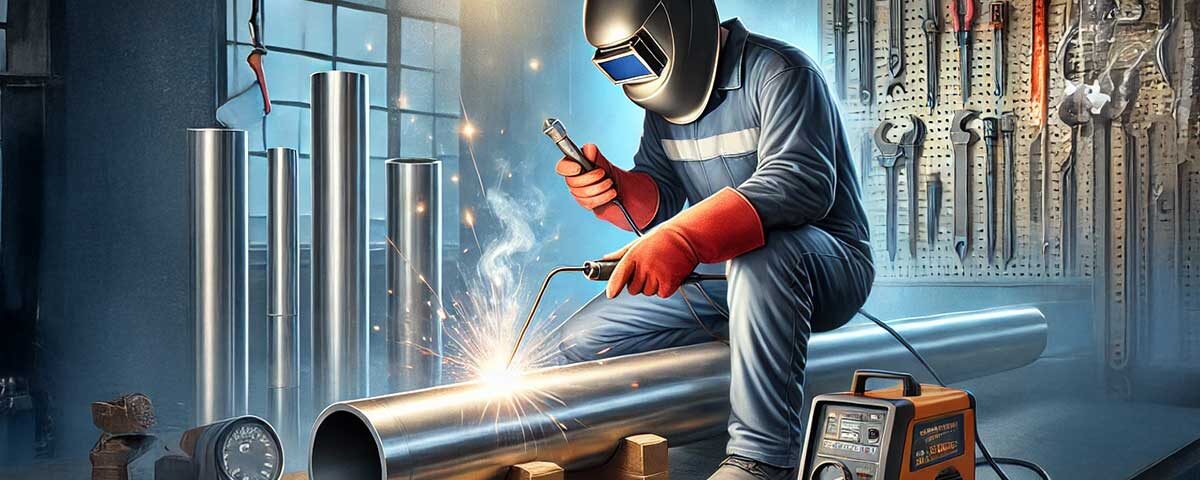- Get Free Quotes
- +91 99209 06048
- +91 22675 21290
- [email protected]
How to Weld Stainless Steel Pipe: Tips and Tricks

Stainless steel pipes are widely used in industries like construction, automotive, and food processing due to their durability, corrosion resistance, and strength. However, welding stainless steel pipes requires precision and expertise to maintain the integrity of the material. In this guide, we will cover essential tips and tricks to achieve high-quality welds.
Why Welding Stainless Steel Pipes is Different?
Stainless steel retains heat more than other metals, making it susceptible to warping, distortion, and contamination. The high chromium content also forms an oxide layer that needs to be carefully managed during the welding process.
Best Welding Techniques for Stainless Steel Pipes
Choosing the right welding method depends on the application, pipe thickness, and desired finish. Here are the most common techniques:
1. TIG Welding (GTAW – Gas Tungsten Arc Welding)
TIG welding is the preferred method for stainless steel pipe welding because it provides high precision and cleaner welds.
- Use a DCEN (Direct Current Electrode Negative) setting for better penetration.
- Use pure argon gas for shielding to prevent oxidation.
- Select ER308, ER309, or ER316 filler rods, depending on the stainless steel grade.
- Maintain a steady arc length to avoid contamination.
- Keep the heat input low to prevent warping and distortion.
2. MIG Welding (GMAW – Gas Metal Arc Welding)
MIG welding is suitable for thicker stainless steel pipes and provides faster welding speeds.
- Use a tri-mix shielding gas (90% helium, 7.5% argon, 2.5% CO2) for the best results.
- Choose ER308L, ER309L, or ER316L wire, depending on the base material.
- Set a low amperage to reduce burn-through.
- Use the push technique to improve gas coverage and prevent oxidation.
3. Stick Welding (SMAW – Shielded Metal Arc Welding)
Stick welding is commonly used for structural applications and repairs.
- Use E308L-16, E309L-16, or E316L-16 electrodes based on the stainless steel grade.
- Maintain a short arc length to minimize spatter and contamination.
- Ensure proper preheating for thicker pipes to avoid cracking.
Tips for Welding Stainless Steel Pipes
1. Proper Surface Preparation
- Clean the surface with a stainless steel wire brush to remove contaminants.
- Avoid using carbon steel tools, as they can introduce rust-causing particles.
- Use acetone or isopropyl alcohol to degrease the welding area.
2. Use the Right Heat Control
- Excessive heat can lead to warping, distortion, and loss of corrosion resistance.
- Use pulsed welding techniques to minimize heat input.
- Allow the metal to cool naturally between passes.
3. Ensure Proper Shielding Gas Coverage
- Poor gas coverage can lead to oxidation and contamination.
- Use a gas lens to ensure even gas flow over the weld puddle.
- Maintain the correct torch angle (15-20 degrees) to shield the arc effectively.
4. Back Purging for Pipe Welding
- To prevent oxidation on the backside of the weld, use argon back purging.
- Tape the pipe ends and use purge dams or inflatable bladders for best results.
5. Avoid Cracking and Corrosion Issues
- Use low-carbon filler metals to prevent carbide precipitation.
- Follow the correct interpass temperature control to avoid stress cracking.
- Post-weld passivation using citric or nitric acid can restore the corrosion resistance.
Common Welding Defects and How to Prevent Them
| Defect | Cause | Prevention |
| Cracking | High heat input, improper filler metal | Use proper preheating, select correct filler metal |
| Porosity | Contaminants, poor gas coverage | Clean surface, ensure good shielding gas flow |
| Warping | Excessive heat input | Use pulsed welding, allow cooling time |
| Oxidation | Insufficient shielding gas | Ensure proper gas coverage, back purging |
| Lack of Fusion | Incorrect amperage or technique | Adjust settings, improve torch angle |
Conclusion
Welding stainless steel pipes requires precision, proper technique, and attention to detail. By using the right welding process, controlling heat input, and ensuring a clean work environment, you can achieve high-quality welds that are strong and corrosion-resistant. Whether you’re in construction, food processing, or industrial manufacturing, following these tips will help you get the best results.










